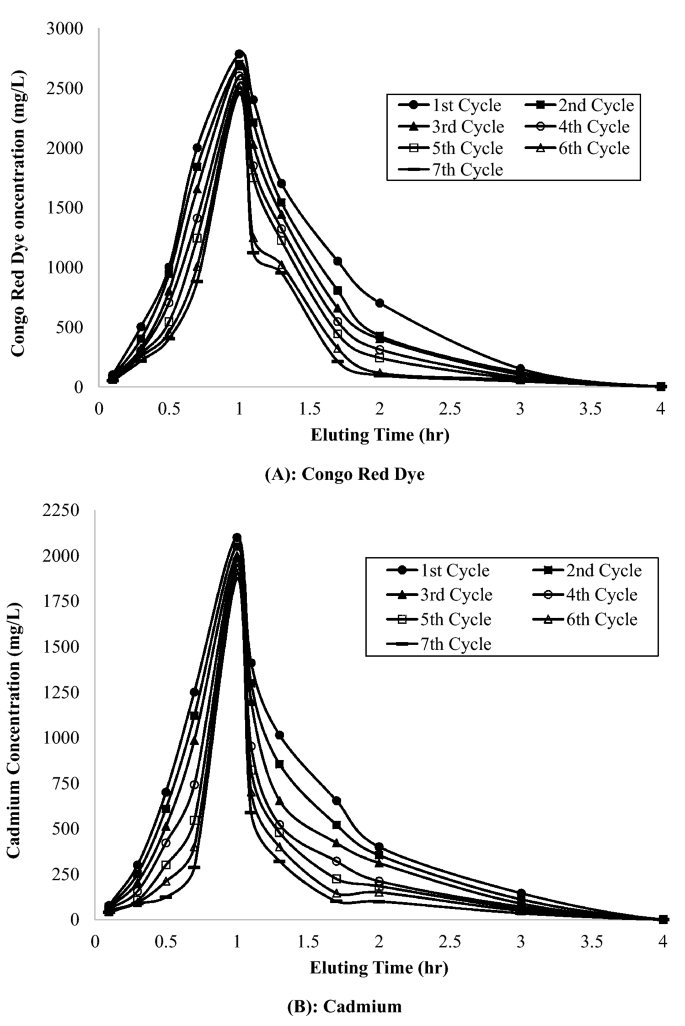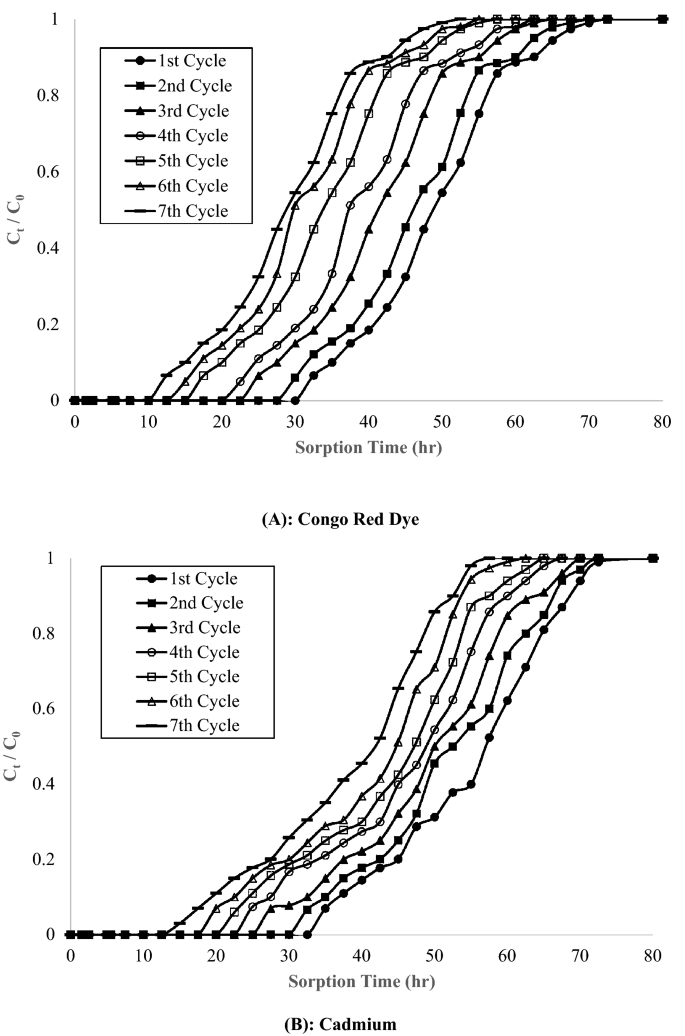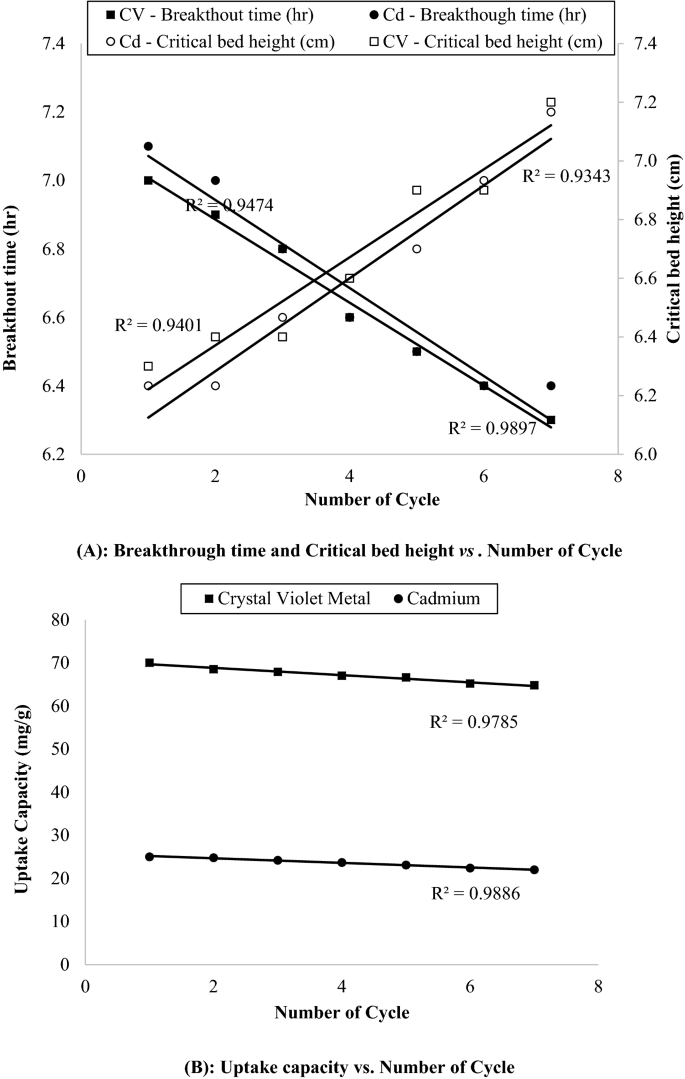Batch study
Batch desorption study was conducted using different types of adsorbates, adsorbents and eluents, in which seven cycles of adsorption-desertion were performed. Table 2 represents the experimental results of Congo red dye and Carbonate ion elution from exhausted GLP and NLP respectively using acids, alkali and solvents as an eluent. Using 0.05–0.20 M acids (hydrochloric acid, sulphuric acid, nitric acid, acetic acid and EDTA), least desorption efficiencies of Congo red dye from GLP were achieved to 1.0–2.3% after first cycles. Also, desorption efficiencies were attained up to 15.1% using all the solvents (rectified spirit, acetone, acetaldehyde, toluene and DCM) as an eluent after first cycles, but, higher desorption efficiencies were attained to 87.5, 98.5, 80.2 and 74.5% using 0.05, 0.10, 0.15 and 0.20 M sodium hydroxide solution respectively using first cycle. Thereafter, efficiencies were continuously decreased by consecutive cycles, so, efficiencies were decreased by 50.4, 58.4, 53.2 and 45.5% using 0.05, 0.10, 0.15 and 0.20 M sodium hydroxide solution respectively using seventh cycle. Using 0.05, 0.10, 0.15 and 0.20 M potassium hydroxide solution, these efficiencies were achieved by 77.5, 87.5, 71.2 and 65.5% after first cycle respectively; and decreased by 41.2, 44.2, 39.5 and 35.4% after seventh cycle respectively. Further, desorption efficiency of Congo red dye from GLP were achieved to 65.2–25.5% using 0.05 to 0.20 M lithium hydroxide, calcium hydroxide and sodium bicarbonate solution as an eluent in first cycle.
Same elution behaviour of carbonate ion from exhausted NLP was observed. Strong as well as weak acid shows the 1.2–2.8% desorption efficiency. Also, desorption efficiencies were attained up to 12.2–14.5% using all the solvents (rectified spirit, acetone, acetaldehyde, toluene and DCM) as an eluent after first cycles. Using 0.05, 0.10, 0.15 and 0.20 M sodium hydroxide solution, higher desorption efficiencies i.e. 86.5, 96.2, 84.4 and 70.2% respectively after first cycle; and 50.2, 55.6, 53.7 and 48.7% respectively after seven cycle were obtained. Also, desorption efficiencies were reached to 90.4, 94.5, 75.5 and 60.5% after first using 0.05, 0.10, 0.15 and 0.20 M potassium hydroxide solution respectively, which was decreased to 35.5, 39.5, 36.4 and 30.2% respectively after seventh cycle. Further, efficiencies were attained from 65.2 to 23.5% using 0.05 to 0.20 M lithium hydroxide, calcium hydroxide and sodium bicarbonate solution as an eluent in first cycle.
From above results, it is reveal that higher desorption efficiencies of anionic Congo red dye or carbonate ion from adsorbent, GLP or NLP respectively using alkaline solution as an eluent, while solvents and acidic solutions were desorbed lesser amount of Congo red dye or carbonate ion. This behaviour attributed to the fact that anionic acid Congo red or carbonate ion were adsorbed onto cationic adsorbent, GLP or NLP respectively. As quantity of adsorbent is abundant higher than adsorbate at equilibrium, so, exhausted adsorbent, GLP or NLP became cationic. Now, cationic adsorbent was reacted with negative charged different alkali, so, negative charge adsorbate i.e. anionic Congo red dye or carbonate ion was eluted from exhausted GLP or NLP due to electrostatic interaction. Further, strong concentration of alkaline solution (0.15 and 0.20 M NaOH) may be damage the structure of exhausted adsorbent and lower concentration of alkaline solution (0.05 M NaOH and all solutions of KOH, LiOH, Ca(OH)2 and NaHCO3) may be slower he desorption mechanism. Solvents, having different functional groups, has slightly affinity to of anionic Congo red dye or carbonate ion, so, minor desorption occurs. But cationic exhausted adsorbent, GLP or NLP was not or negligible eluted anionic Congo red dye or carbonate ion using cationic acidic solution due to common ion effect. Hence, 0.1 M NaOH shows highest desorption capacity for anionic Congo red dye and carbonate ion.
Table 3 depicted desorption efficiency of Methylene blue, Cadmium (Cd) Cadmium (Cd) from NLP, NLP and charcoal prepared from NLP respectively using acids, alkali and solvents as an eluent, in which acidic solutions show excellent results, while alkaline solutions and solvents had least results. Using 0.05, 0.10, 0.15 and 0.20 M HCl solution, desorption efficiencies of methylene blue dye from NLP were obtained 93.5, 97.8, 81.2 and 75.5% respectively after first cycle. Then, continuous decrements were found after completion of each cycle. Finally, these efficiencies were decreased up to 55.5, 60.2, 50.7 and 48.5% using 0.05, 0.10, 0.15 and 0.20 M HCl solution respectively after seventh cycle. The desorption efficiencies were attained to 87.5, 91.5, 80.3 and 70.5% after first cycle and 53.9, 57.5, 50.2 and 42.5% after seventh cycle using 0.05, 0.10, 0.15 and 0.20 M H2SO4 solution respectively. Moreover, desorption efficiency of methylene blue dye from NLP was achieved in range of 53.2 to 30.2% using 0.05 to 0.2 M HNO3, CH3COOH and EDTA solution. Also, least efficiencies i.e. 11.5–13.2% and 0.9–2.1% were observed using different solvents and alkaline solutions respectively.
The desorption efficiencies of Cadmium (Cd) from NLP were reached in range of 93.4–70.2% after first cycle and 55.7–44.4% after seventh cycle using 0.05–0.20 M HCl solution respectively, while using other acidic solutions (0.05–0.2 M HNO3, CH3COOH and EDTA solutions), different solvents and alkaline solution, lower efficiencies were attained in range of 48.5–27.5, 11.8–14.1 and 1.0–2.6% respectively. Further, Cadmium desorption from AC-NLP was performed and found that efficiencies were achieved up to 97.2–78.8% after first cycle and 59.8–47.5% after seventh cycle using 0.05–0.20 M HCl solution. Also, these efficiencies were attained up to 89.7–31.2, 12.5–15.6 and 1.2–3.0% using other acidic solutions (0.05–0.20 M HNO3, CH3COOH and EDTA solutions), different solvents and alkaline solution respectively.
Here, acidic solution as an eluent shows greater desorption efficiencies for elution of cationic methylene blue dye and cadmium (Cd) metal from NLP and AC-NLP. But, solvents and alkali solutions show least desorption behavior. Here, first cationic methylene blue dye and cadmium (Cd) were adsorbed onto anionic NLP and AC-NLP. Amount of adsorbent is plentiful higher than adsorbate at equilibrium, so, positive charged (anionic) was occurs on exhausted NLP and AC-NLP. Then, anionic exhausted was contacted with positive charged acidic solution, which eluted cationic methylene blue dye and cadmium (Cd) metal from NLP and AC-NLP due to electrostatic interaction. Further, strong acid (H2SO4) and weak acids (HNO3, CH3COOH and EDTA) shows lesser desorption than using moderate potential acid (HCl). Higher concentration i.e. 0.15 and 0.20 M HCl may be damage the structure of adsorbent and lower concentration i.e. 0.05 M HCl may be delay the desorption process. While, solvents and alkali solution shows slight and negligible desorption. Also, it was observed that AC-NLP has higher desorption efficiency for cadmium than NLP. Thus, 0.1 M HCl shows maximum desorption capacity for methylene blue dye and Cadmium (Cd) metal. Further, activated charcoal has three types of pores according to diameters i.e. micropore, mesopore and macropore, so, eluent may be easily penetrated into these pores of AC-NLP than pure NLP.
From this section, we concluded that higher desorption efficiencies of anionic Congo red dye or carbonate ion from adsorbent, GLP or NLP respectively using acid as an eluent. Also, alkaline solution as an eluent shows greater desorption efficiencies for elution of cationic methylene blue dye and cadmium (Cd) metal from NLP and AC-NLP. Strong acid may be destroyed the structure of adsorbent and weak acid may be slower the desorption mechanism. AC-NLP has higher desorption efficiency for cadmium than native NLP. Hence forward, anionic and cationic adsorbate will be eluted using 0.1 M hydrochloric acid and 0.1 M sodium hydroxide solution respectively in kinetic and column study8.
To determine the desorption mechanism, elution profile of Congo red dye and cadmium metal was studied using 0.1 M hydrochloric acid and 0.1 M sodium hydroxide solution respectively for contact duration of 30, 60, 120, 180, 240 and 300 min. These data were evaluated by kinetic isotherm i.e. Pseudo-First order, Pseudo-Second order, Intra-particle diffusion and Elovich isotherm. Table 4 represented the enlisted kinetic isotherms used, their equations, their linear plots, and their correlation coefficient values (R2) for elution of Congo red and cadmium. Highest R2 values (0.9987 and 0.9974) were obtained from Pseudo-First order. Another kinetics isotherm had R2 values were in range of 0.9900–0.9711. These values revealed that desorption of Congo red and cadmium follows Pseudo-First order. This is due the fact that desorption process depends upon two reactants i.e. adsorbate and eluent, but quantity of eluent is too much excess compared to adsorbate. So, rate of desorption is depends upon adsorbate only.
Column study
Desorptive column study was performed using 0.1 M hydrochloric acid and 0.1 M sodium hydroxide solution for elution of Congo red and cadmium metal from GLP and AC-NLP respectively at flow rate 5 mL/min and bed height of 10 cm; total seven cycles were performed. From these data, breakthrough and desorption curves were plotted. First, sorption column was packed with exhausted adsorbent i.e. GLP or AC-NLP (quantity: 12.4–10.5 g) with packing density 215 g/L and bed height of 10 cm. And after completion of seven cycle, only 9.5–7.4 g dry adsorbent mass having packing density 151.1–149.2 g/L and bed height of 8.7–8.0 cm was left behind in column, which shows weight loss of 30.1–35.0%.
The flow rate of desorption (5 mL/min) is selected slightly lower than previous adsorption study (10 mL/min), which promotions higher sorption of the sorbate into the available sites on the adsorbate resulting in a higher binding17. Figure 1 shows the elution breakthrough curves of Congo red dye and cadmium metal, which shows higher elution of adsorbate from NLP and AC-NLP initially. Thereafter, slow elution of both adsorbates was presented. Same type of desorption behaviour were observed by Fagundes-Klen et al.18 and Lodeiro et al.19 in their experiments. Also, Table 5 depicted the different sorption and elution process parameters for seven sorption–desorption cycles. The desorption process slowly decreased with increment of number of cycles, as per batch study. The percentage update capacity of dye was obtained by 70.0 to 64.8 mg/g for dye and 25.0 to 22.0% for metal from first cycle to seventh cycle respectively. Further, percentage removal of dye (85.5 to 56.3%) and metal (88.8 to 60.5%) was decreasing with number of cycles (Table 5).
Figure 2 depicted the sorption breakthrough curves for Congo red and cadmium. Both the adsorbates had lowest slope initially, which revealed high adsorption capacity in the first cycle. Then, with increasing number of cycles, the slope became sleeper, which show lower adsorption capacity. It is also confirmed by decreasing value of rate constant-dC/dt (8.5 to 3.3 mg/L·h for Congo red and 8.1 to 2.9 mg/L·h for Cadmium) and enlargement of mass transfer zone-∆t (22.5 to 38.9 cm for Congo red and 23.4 to 38.3 cm for Cadmium) with number of cycles, mentioned in Table 5. Further, equilibrium was attained after 3.6 h for both adsorbates, which lower than batch desorption study (6.0 h). Also, total quantity of eluent used for batch and column study were 250 mL and 189.5 mL per exhausted adsorbent respectively. So, it is revealed that column desorption study is more feasible than batch study.
Figure 3A,B represents the breakthrough time and critical bed length vs. number of cycle and uptake capacity vs. number of cycle (x) respectively, which is straight line having coefficient of determination (R2) value greater than 0.93. This indicate the applicability of all activity-indicator equation in desorption study. Table 6 presents the different parameter of activity-indicator equation. From the plot of breakthrough time vs. number of cycle i.e. x, tb,0 and ktb were attained up to 7.1286 h and 0.1286 h/cycle for Congo red respectively; and 7.2 h and 0.1214 h/cycle for cadmium respectively. Therefore, it can be assisted that sufficient capacities to escape the breakthrough at time t = 0 for up to 55 cycles for both adsorbates, Congo red and cadmium. Value of Q0 and kQ were achieved up to 70.5 mg/g and 0.8393 mg/g·cycle for Congo red respectively; and 24.729 mg/g and 0.5321 mg/g·cycle respectively derived from plot of uptake capacity vs. x. Thus, it can anticipated that column may be completely exhausted i.e. no uptake after 84 and 48 cycles for Congo red and cadmium respectively. These two different values implies due to the fact that initial concentration of methylene blue and cadmium were different i.e. 75 and 25 mg/g respectively in previous adsorption experiments. Also, from the plot of critical bed length vs. x, Zm,0 and kZm were attained up to 9.0174 cm and 0.15 cm/cycle for Congo red respectively; and 6.1714 cm and 0.1357 cm/cycle for cadmium respectively, which shows that breakthrough would be performed after 40–45 cycles at time t = 0.





